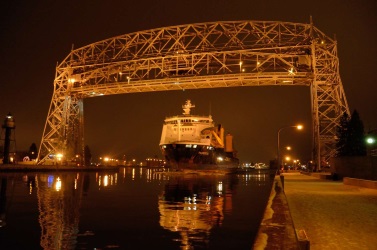
| December 30, 2014 | |
Transitions: Duluth/Superior
![]() Print this Article | Send to Colleague
Print this Article | Send to Colleague

Departure of the
Palmerston, Duluth/Superior last saltie of 2014. Photo: Duluth Seaway Port
Authority
The last oceangoing vessel to call the Port of Duluth/Superior this year departed just after midnight Friday, Dec. 19 – passing beneath the Aerial Lift Bridge at 12:26 a.m. Saturday. The Palmerton had arrived earlier in the week to discharge project cargo at the Clure Public Marine Terminal in Duluth.
The Welland Canal, which connects Lakes Erie and Ontario, and the Montreal-Lake Ontario section of the Seaway are scheduled to close on Dec. 31.
Great Lakes vessel activity will continue until the closure of the Soo Locks at Sault Ste. Marie (MI), which is scheduled for midnight on Jan. 15. The locks, which link Lake Superior and the lower Great Lakes, are due to reopen for the 2015 commercial navigation season on March 25.
Despite severe icing and rail capacity issues in March and April, the port through November had handled some 32.4 million short tons of cargo through November, or nearly as much as in 2013 season. Iron ore shipments to domestic and Canadian steel mills were up nearly 6 percent. Tonnage increases in general cargo and commodities such as limestone and salt helped offset declines in coal and grain this season.
"Higher water levels across the system this year helped tremendously in making up time and tonnage," said Vanta Coda, executive director of the Duluth Seaway Port Authority. "Thousand-footers, for example, were able to load to another foot deeper draft allowing some 3,000 additional tons of iron ore or coal on every down bound delivery. General cargo shipments also ranked significantly higher than last year. By the time 2014 ends, we will have welcomed 14 vessels to the Clure Public Marine Terminal here in Duluth, nearly twice as many as last year, representing a tonnage increase of more than 200 percent."
Although ice has already formed on Lake Superior and elsewhere in the system, shipping has not been significantly impacted so far this winter. Freighters continue to deliver iron ore to mills on the Lower Lakes to ensure sufficient inventories for steelmaking while locks are closed, to build up stockpiles of coal at utility companies and other customers in that same region, and, on the inbound side, to ensure there are sufficient supplies of limestone, salt and other bulk commodities on the ground here in the Twin Ports to last until the locks reopen in March.
